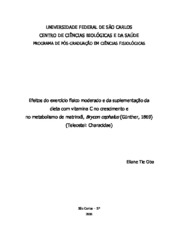Efeitos do exercício físico moderado e da suplementação da dieta com vitamina C no crescimento e no metabolismo de matrinxã, Brycon cephalus (Günter, 1869) (Teleostei:Characidae)
Abstract
Moderate exercise training is known to enhance fish appetite, feed conversion efficiency and
growth rate. This type of exercise raises the hematocrit, thus blood hemoglobin concentration and the
oxygen carrying capacity of the blood. This allows that less blood needed to be diverted away from
the gut to supply aerobic metabolism in the muscles. Continuously swimming fish show lowered
circulating levels of stress hormones (like cortisol) and this represents an energy saving and permits
higher fish growth rate, with more homogenous body size. All aerobic living forms have defenses
against reactive oxygen species. Oxygen consumption can increase with exercise training and this
result in a higher production of reactive oxygen species. Antioxidants, like vitamin C, in the diet can
reduce the disease risks and the oxidative damage by the reactive oxygen species. The aim of this
study was to verify growth and oxidative metabolism of matrinxã, Brycon cephalus, after moderate
and continuous exercise training (speed 1 2 BL.s-1) and after fed with vitamin C supplemented diet
(432 mg AA.kg dieta-1). Matrinxãs were divided into four groups: Control (submitted to diet without
vitamin C supplementation and to sedentarism), Vit.C (submitted to diet with vitamin C
supplementation and to sedentarism), Exe (submitted to diet without vitamin C supplementation and
to exercise training) and Vit.C+Exe (submitted to diet with vitamin C supplementation and to exercise
training), during 60 and 90 days. After these treatments, matrinxãs were anesthetized and blood
samples were collected with heparinized needles and syringes by caudal vein puncture. Fish were
sacrificed by vertebral section, weighed and lengthened. Liver, white and red muscle and heart were
collected for the biochemistry analysis. Plasma cortisol levels, liver vitamin C concentration,
intermediary metabolite levels (glucose, glycogen, lactate, pyruvate and ammonia) and oxidative
stress indicators (lipid hydroperoxide, superoxide dismutase and glutathione peroxidase) were
measured. The exercise training increased growth rate of matrinxãs indicated by the condition factor
and the maintenance of the liver glycogen levels and the higher muscle protein concentration. This
moderate swimming exercise raised the hematocrit of matrinxãs and lowered the plasma cortisol
levels. The vitamin C supplemented diet enhanced hepatic levels of this vitamin. This supplementation
did not permit the increase of growth rate, however it reduced the lipid peroxidation levels. Exercise
and vitamin C supplemented diet associated were responsible for the maintenance lipid peroxidation
and antioxidants enzymes levels. After 90 days of experiment period, the group Vit.C+Exe showed
similar growth and condition factor to the group Exe. The moderate exercise training with vitamin C
supplemented diet increased the growth and the survive rates of matrinxãs, B. cephalus, due to the
some alterations on the metabolism, improving the fish condition and favoring the fisheries
production.
